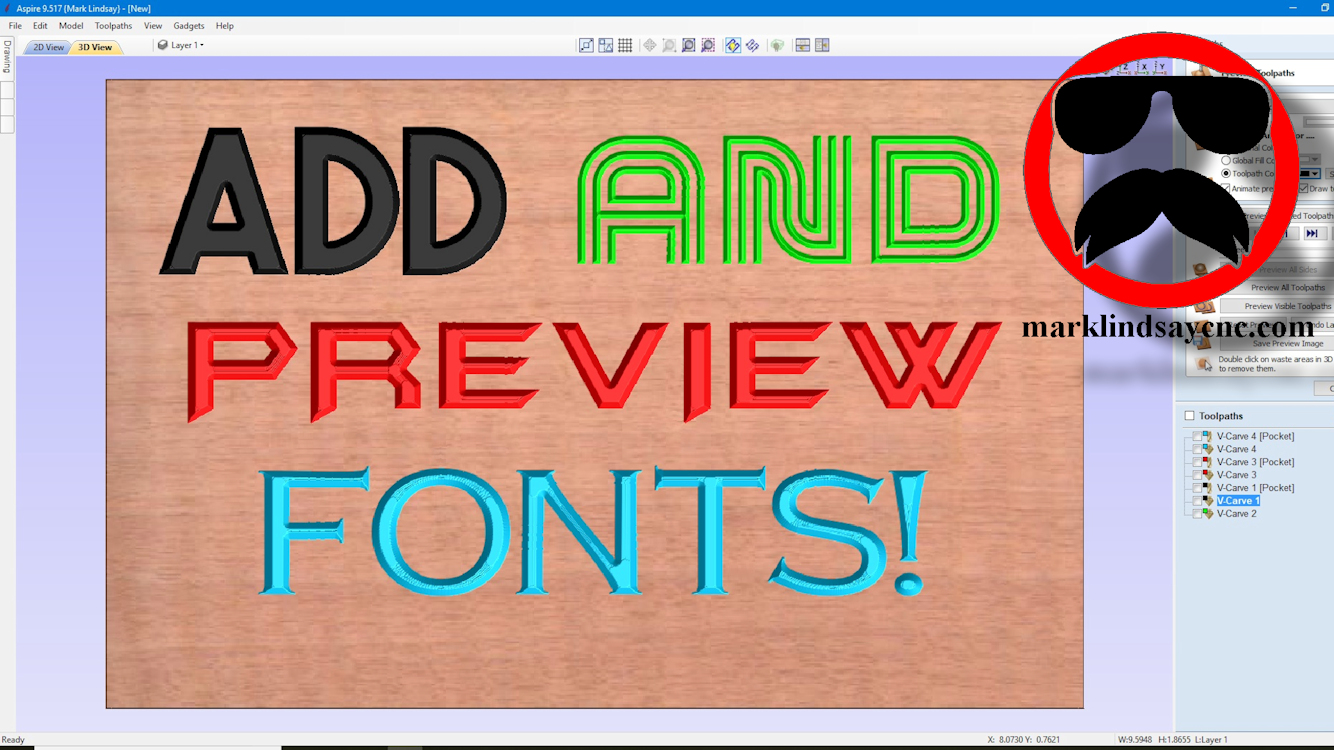-
Using the Triple Edge Finder from The Maker’s Guide with the Xylotex Drive Box Part 3
Putting the Triple Edge Finder to Work Easily, the most popular question I get is how I hooked up my Triple Edge Finder (TEF) to my Xylotex Drive Box for use with my Shoestring Budget CNC Router. This article is part 3 of a series in which I’ll explain what I needed to buy, how I hooked everything up, what settings I used in Mach3, and how I use it in normal day to day operations. This article is meant to accompany my video tutorial, which can be viewed on my YouTube channel right here. With everything installed, configured, assembled and connected, it’s time to test and put the…
-
Using the Triple Edge Finder from The Maker’s Guide with the Xylotex Drive Box Part 2
Connection and Configuration Easily, the most popular question I get is how I hooked up my Triple Edge Finder to my Xylotex Drive Box for use with my Shoestring Budget CNC Router. This article is part 2 of a series in which I’ll explain what I needed to buy, how I hooked everything up, what settings I used in Mach3, and how I use it in normal day to day operations. This article is meant to accompany my video tutorial, which can be viewed on my YouTube channel right here. With all of the parts ordered, and hopefully received by now, it’s time to start assembling everything. First, we’ll…
-
Uncategorized
Using the Triple Edge Finder from The Maker’s Guide with the Xylotex Drive Box Part 1
The Breakout Board and Mach3 Toolsetter Screen Set This is a companion article that goes with my YouTube video, posted here. Easily, the most popular question I get is how I hooked up my Triple Edge Finder to my Xylotex Drive Box for use with my Shoestring Budget CNC Router. This article is part 1 of a series in which I’ll explain what I needed to buy, how I hooked everything up, what settings I used in Mach3, and how I use it in normal day to day operations. [expand title=”Read More”] To get started, we’ll need to get the Triple Edge Finder itself, obviously. You can get yours over at…
-
Uncategorized
Converting Metric Vectors to Imperial (or Vice Versa) in VCarve, Aspire, and Cut2D
Converting from Metric to Imperial is easy. Have you ever imported a DXF file into your Vectric software, only to find that it’s incredibly huge, or unbelievably small? Well, maybe the vector file was drawn in a different unit of measure. [expand title=”Read More”] When you import a DXF file into VCarve, Aspire, or Cut 2D, the software imports the file as drawn. It doesn’t convert from one unit of measure to another. So if you’re working in Imperial units and import a file that was 200 mm long, Vectric assumes that it’s 200 inches. Obviously that’s a problem. Usually, converting those vectors from metric to Imperial solves the problem. To…
-
Uncategorized
Eliminating Unnecessary Points from Vectors in VCarve, Aspire, and Cut 2D
One of the side effects of importing vectors from a separate CAD or graphics program is that you’re importing those vectors as drawn by the file’s creator. While there’s nothing inherently wrong with that, it can lead to side issues if some of the basics aren’t addressed. Among these basics are the numbers of points in the vectors and what type of vectors they are. [expand title=”Read More”] As I’ve mentioned before in previous posts, there are three types of vectors: arcs, curves, and lines. All vectors are based on one of these three types. It may or may not be readily apparent as to which type of vector the file’s…
-
Uncategorized
Joining Vectors that Just Won’t Join in VCarve, Aspire, and Cut 2D
Sometimes we get what looks like a design that’s ready for toolpathing, even though it’s not. Trying to calculate even simple profile toolpaths just won’t work. Sometimes you’ll get an error message in VCarve, telling you that a certain number of vectors will be ignored if you proceed. In most cases, this error message is caused by open vectors that just need to be joined. But what do you do when they won’t join? [expand title=”Read More”] Normally you can just select the open vectors and use the Join Open Vectors tool in the Edit Vectors section. But what if that doesn’t work? In the video, I’ll show you some different…
-
Uncategorized
What Exactly is a Vector?
Sometimes we take the simplest things for granted. As an example, I started making CNC videos a little less than a year ago, and I thought I was making basic videos for the absolute beginner. Well, it turns out I haven’t been doing that at all. I fell into the same trap a lot of other people make, and that is assuming that folks already know what I’m talking about when I use certain words and phrases. Take the word Vector. I had never given it much thought. I figured that if a person was interested in CNC, they probably already had some basic knowledge of how they worked, and…
-
Uncategorized
Down with Double-Sided Tape!
I hate double-sided tape. I mean with a flaming red passion. Why? Pull up a chair and I’ll tell you. [expand title=”Read More”] In my experience, the double-sided tape I’ve used to mount a project or template falls into two main categories; either the adhesive is too weak, allowing the material you’re trying to hold to move, or it’s too strong, requiring you to use extreme measures such as open flame or blasting to get the material off after you’re finished running it, or abandon the project in place and move on. Nope – I don’t like it at all. I plodded along in life, using the horrible stuff, figuring I…
-
Uncategorized
Using Dingbats in VCarve and Aspire
Dingbats are free vector graphics that you already have installed on your Windows based PC. So what are Dingbats? Historically speaking, Dingbats are little ornaments that were used to decorate printed pages. Although they were also used as place holders or spacers, they were usually used to frame images or add graphics to a page. [expand title=”Read More”] In computer terms, a Dingbat is a small graphic image used to convey information, such as arrows, punctuation marks, or even just small images for decorative purposes. If you’ve ever used a word processor and searched through the font list, you’ve probably come across them under the name Wing Dings or something…
-
Uncategorized
Grouping Vectors, Creating Layers, and Creating Linear Arrays in VCarve, Aspire, and Cut 2D
There are times when you’ll want to create several copies of a single part and calculate toolpaths to cut them all out. Fortunately for us, the folks at Vectric have included several ways of getting the job done without the need to draw each individual copy. The use of layers, linear arrays, and grouping vectors all come together to make this task a lot easier. [expand title=”Read More”] Since VCarve Pro is a Windows based program, there are several ways to do the same thing. I’ll demonstrate one way to get the job done in this video. In the video, I draw out 150 small parts for a fictitious customer.…





